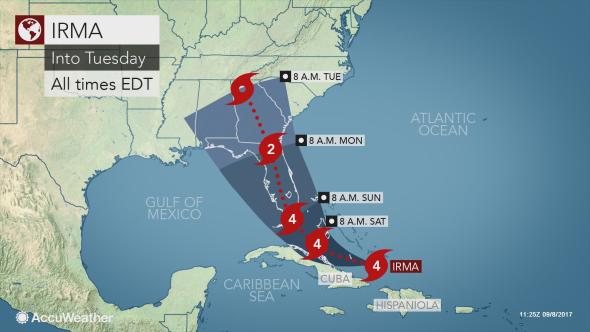|
According to The National Hurricane Center, the “two most efficient ways of staying safe during a hurricane are preparing in advance and then acting on those preparations." Hurricane Irma is currently a Category 5 storm with winds gusts over 180 mph. Florida has already declared a state of emergency and Georgia and South Carolina could be in its path.
The first priority should be the safety of your family. Make a family plan and go over it with your family. Don't wait until the last minute. Cell phones may not be operable or left behind. FEMA recommends keeping an emergency supply kit on hand at all times — especially when the threat of a severe weather event arises. The kit should include:
In addition to the emergency kit, every family should develop an emergency plan which includes:
If there is no mandatory evacuation in place, keep your car in good working order with a full tank of gasoline. If an evacuation order comes, leave immediately with your emergency kit. If you stay in your home, avoid lighting candles. Flashlights with extra batteries should be part of your preparation. Also, keep your cell phone charged as long as possible. Before the power goes out, turn your freezer and refrigerator to the coldest settings 6 hours before the storm hits and move as much food as possible into the freezer because the food will last longer. Avoid opening the refrigerator and freezer doors as much as possible to keep the cold air in. Freezing ice packs for coolers is another way to prepare for power outages. Portable generators are an important addition to your preparations. Read all directions about their use and protect them from moisture. Keep them outside away from windows and doors. FEMA also recommends filling sinks and bathtubs with water for use in flushing toilets or washing. Home preparations include making sure rain gutters are secure to the house, clearing clogged drains to prevent water buildup and, if possible, stockpiling sand bags, plastic sheeting and plywood. Install sump pumps with backup batteries and a water alarm to let you know when the system is overloaded. More costly, and long term preparations can include waterproofing your basement, elevating your heating system, water heater and electric panel above flood water height. Unplug appliances and move items such as furniture and valuables which are light enough to carry to higher floors of your home. Reinforce doors, windows, walls and roofs beforehand as much as possible. Taping windows is not a good option since glass could break into larger shards. Bring in any outdoor furniture and anchor items such as propane tanks. Trimming and removing damaged trees and low-hanging limbs will reduce the risk of them causing damage, and if available, install storm shutters. Take photos of your house and its belongings before the storm. After the storm hits, take as many photos as possible of the initial damage and prevent additional damage by covering ceiling holes with tarps. Some insurance plans may not cover losses sustained after the storm. After the storm:
Harper Construction hopes that this information was helpful and hope you and your family stay safe during this hurricane season. Please “Like” and “Share” this information with all your friends and family.
0 Comments
Leave a Reply. |


